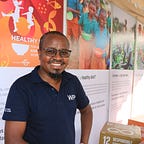Bamba Chakula: A saviour in times of reduced rations in Kenya
WFP cash transfers to 420,000 refugees have transformed lives in and around camps but are now under threat of running out of funding in the new year
Mumina Abdi is a refugee who has lived in Dadaab in eastern Kenya since camps here first opened almost 30 years ago with an influx of people fleeing war in Somalia. She is about 50. The Dadaab camps house almost 220,000 people.
“I came from Baidoa [in southwest Somalia] as a young mother. My children are all grown now. I haven’t been back to Somalia ever since,” Mumina says.
Over the years, she has lived through lows and highs in Dadaab. She describes life today as very different from when she arrived and remembers collecting prized commodities such as sugar at monthly World Food Programme (WFP) distributions.
“The world is faced with too many crises today,” she says. “I hear about the problems in countries like Syria over the radio. I think this is the reason why we are not receiving as much assistance nowadays.”
Coping with reduced rations
For the last five years, WFP has struggled to keep its food rations at full levels. Funding shortfalls have forced WFP to make deep ration cuts for long periods, greatly impacting the lives of refugees. Many do not have any other source of food.
Currently, WFP provides 70 percent of the recommended minimum amount of food for a healthy life to each refugee. This round of ration cuts have lasted over a year — threatening the nutritional status of the most vulnerable.
There are few opportunities for work in the camps and when they arise they pay little. It is illegal for refugees to work outside the camps. Those who succeed in business do so through running their own enterprises inside the camps.
At a monthly food distribution, Dunia Mohamed collects rice, split peas and vegetable oil for her family of three.
“We are grateful to WFP for continuing to provide us with food,” she says. “The rations are smaller, but I will buy additional items with Bamba Chakula so I’m not worried. With Bamba Chakula, I will buy some pasta, vegetables, meat, and milk.”
More cash, more respite, brisk business
With support from the EU Humanitarian Aid, Germany, UK Aid, and the United States Agency for International Development, WFP recently increased its Bamba Chakula (Get Your Food) cash transfers to refugees in camps both at Dadaab and Kakuma, which is in northwest Kenya.
Today, each refugee receives 500 Kenyan shillings (almost US$5) per month. When WFP introduced cash assistance in Dadaab in 2016, each refugee received 100 Kenyan shillings each month. The low initial value and gradual increase was necessary to protect markets in the camps, allowing businesses to absorb the increased demand without distorting food prices upwards.
WFP now substitutes 50 percent worth of the staple cereal component of in-kind food rations with cash, giving refugees the freedom to buy their preferred foods from now thriving markets, as well as diversifying their diets.
“I have run this shop for almost eight years,” says Duale Briye Rage, a Kenyan shopkeeper in Ifo camp. “There was a big surge in business when Bamba Chakula started, and even now when the cash was increased, you can tell that the refugees are buying a little bit more.”
Dunia Mohamed says that with increased cash, she can buy more food and no longer has to resort to borrowing money to cover her family’s food needs. “We would like for Bamba Chakula to be increased again and again,” she adds.
Diverse, healthy diets
Farhar Abdullahi Muse and his wife Dalmar Abdi Adan run a grocery stall in Ifo. As a family of six, they receive to 3,000 Kenyan shillings per month. He says that his wife is solely responsible for the family’s Bamba Chakula cash.
“Dalmar goes to the market and buys food items based on what she wants us to eat,” says Farhar. “I will get home from the shop and find a meat dish or wake up to eggs for breakfast — she does it all with the Bamba Chakula.”
Food markets in Ifo, like the other camps, are vibrant, offering a wide variety of food ranging here from fresh camel milk to canned milk, beef, mutton or nyirnyir — camel meat — dry locally grown grain and imported rice and pasta. Families have a wide choice.
Unhealthy cash pipeline
But at the moment, WFP again faces a serious shortage in its flow of funding providing for cash transfers, to the extent that if new funds are not urgently received from donors, there could be a complete halt to cash disbursements.
“That would be disastrous — and not just for refugees, but also for us, business owners,” says Faatumo Burale Ilmuge, another self-made trader in Ifo. “If the cash dries up for the refugees, it also dries up for us business people, whether Kenyans or refugees.”
WFP has a six-month overall funding shortfall for its refugee operation in Kenya of US$29 million from January to June 2020 and its risks completely running out of cash for the transfers in March unless it receives more support.
WFP provides food assistance to 420,000 refugees in Kenya at a cost of US$7.5 million per month; US$2.5 million of which is spent on cash transfers.
Click here for more on WFP’s work in Kenya.
